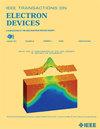基于catboost的z干涉建模精确预测缩放三维NAND闪存阈值电压分布
IF 3.2
2区 工程技术
Q2 ENGINEERING, ELECTRICAL & ELECTRONIC
引用次数: 0
摘要
本文提出了一种机器学习方法,使用CatBoost回归来模拟缩放三维nand闪存中的z -干扰(Z-INF)效应。随着字行(WLs)的垂直整合增加比特密度,基音尺度增强了细胞间的干扰,扩大了阈值电压(${V}_{\text {th}}\text{)}$分布,并减少了感知边界。传统的TCAD仿真和指数函数拟合可以处理双参数关系,但不能充分模拟影响Z-INF的多个变量。我们提出的三参数模型结合了具有受害者细胞特征的攻击细胞的初始和最终状态,同时在较小的细胞维度上保持了对其他因素的可扩展性。实验结果表明,该模型准确预测了${V}_{\text {th}}$分布在各种WL几何形状上的变化,提高了计算效率。分析表明,当氧化物/氮化物(ON)间距从50 nm减小到40 nm时,Z-INF增加4-5倍,在45 nm以下发生临界降解。该模型成功地解释了工艺变化并确定了缩放阈值,为先进的3d nand架构的可靠性改进和纠错提供了见解。本文章由计算机程序翻译,如有差异,请以英文原文为准。
CatBoost-Based Z-Interference Modeling for Accurate Prediction of Threshold Voltage Distribution in Scaled 3-D NAND Flash
This article presents a machine learning approach using CatBoost regression to model Z-interference (Z-INF) effects in scaled 3-D nand flash memory. As vertical integration of word-lines (WLs) increases bit density, pitch scaling intensifies cell-to-cell interference, widening threshold voltage ( ${V}_{\text {th}}\text {)}$ distributions, and reducing sensing margins. Conventional TCAD simulations and exponential function fitting can handle two-parameter relationships but cannot adequately model multiple variables affecting Z-INF. Our proposed three-parameter model incorporates both initial and final states of attack cells with victim cell characteristics, while maintaining extensibility for additional factors at smaller cell dimensions. Experimental results confirm that the model accurately predicts ${V}_{\text {th}}$ distribution changes across various WL geometries with improved computational efficiency. Analysis shows Z-INF increases 4–5 times when oxide/nitride (ON) pitch decreases from 50 to 40 nm, with critical degradation below 45 nm. The model successfully accounts for process variations and identifies scaling thresholds, providing insights for reliability improvement and error correction in advanced 3-D nand architectures.
求助全文
通过发布文献求助,成功后即可免费获取论文全文。
去求助
来源期刊

IEEE Transactions on Electron Devices
工程技术-工程:电子与电气
CiteScore
5.80
自引率
16.10%
发文量
937
审稿时长
3.8 months
期刊介绍:
IEEE Transactions on Electron Devices publishes original and significant contributions relating to the theory, modeling, design, performance and reliability of electron and ion integrated circuit devices and interconnects, involving insulators, metals, organic materials, micro-plasmas, semiconductors, quantum-effect structures, vacuum devices, and emerging materials with applications in bioelectronics, biomedical electronics, computation, communications, displays, microelectromechanics, imaging, micro-actuators, nanoelectronics, optoelectronics, photovoltaics, power ICs and micro-sensors. Tutorial and review papers on these subjects are also published and occasional special issues appear to present a collection of papers which treat particular areas in more depth and breadth.
 求助内容:
求助内容: 应助结果提醒方式:
应助结果提醒方式:


